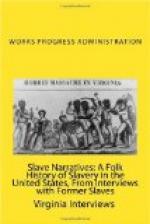In the continuation of her narrative, “Aunt” Mary said that the Littles trained her to be a nurse. Before the war ended, she was inherited by Mr. Gus (the late Hon. W.A.) Little.
She remembers that all the “quality”, young white men who went to the war from Talbotton took Negro men-servants (slaves) along with them. These were usually called body-servants, and it was a body-servant’s duty to cook, wash, and do general valet service for his master. In a pinch, he was also supposed to raid a hen roost, or otherwise rustle food for his “white fokes”.
According to “Aunt” Mary, the Little Negroes were very religious and given to much loud praying and singing, which often so disturbed Dr. Little that he gave orders for them to stop it, and also ordered that all lights in the slave quarters be out at 9 o’clock each night.
“So us tuck to slippin’ off to a big gully in de pastur to sing and pray whar de white fokes couldn’ hear us.
“My fust baby wuz bawned in 1862, during de secon’ year o’ de war. I has had several husbants, my las’ un, he died ’bout seventeen years ago.
“I ain’t never seed but one hant in my life, an’ I didn’ know it wuz a hant ’til Aunt Peggy (an old slave woman) tole me so. Dis hant was in de shape o’ a duck, an’ it followed me one day frum de big house kitchen ter de hawg pen whar I wuz gwine ter slop de hawgs. When I got back, I said, ‘Aunt Peggy, dar’s a strange duck done tuck up wid us!’ And she say, ‘hush, chile, dat’s a hant!’ I been seein’ ’im fur severrel years! An’ dat sholy skeert me!”
When asked if she had ever been whipped when a slave, “Aunt” Mary replied, “Yes, and thank God fur it, fur ole Miss taught me to be hones’ an’ not to steal.” She admitted that being whipped for stealing made her an honest woman.
“Aunt” Mary’s oldest child is now a man of 74. Her hair is as white as cotton and her eye sight is dim, but she is still mentally alert. She says that colored people are naturally religious and that they learned all their “devilment” from the Whites. She deplores the wickedness into which the world has drifted, but thanks God that slavery ended when it did.
She has never had any particular love for the Yankees, and thinks that they treated the Southern white folks “most scandalously” after the war, yet feels that she owes them a debt of gratitude for freeing her people. She admits that her awful hatred of slavery was born of her sad experience as a girl when she was so unceremoniously separated from her loved ones, as previously told. She is also of the firm opinion the those “speculataws” who brought her from Maryland to Georgia in 1860 are “brilin in hell fur dey sin” of seperating her from her people.
Must Jesus bear the cross alone and all the world go free? No, there is a cross for every one; there’s a cross for me; This consecrated cross I shall bear til death shall set me free, And then go home, my crown to wear; there is a crown for me.
Sung for interviewer by Mary Ferguson, ex-slave, December 18, 1936.




